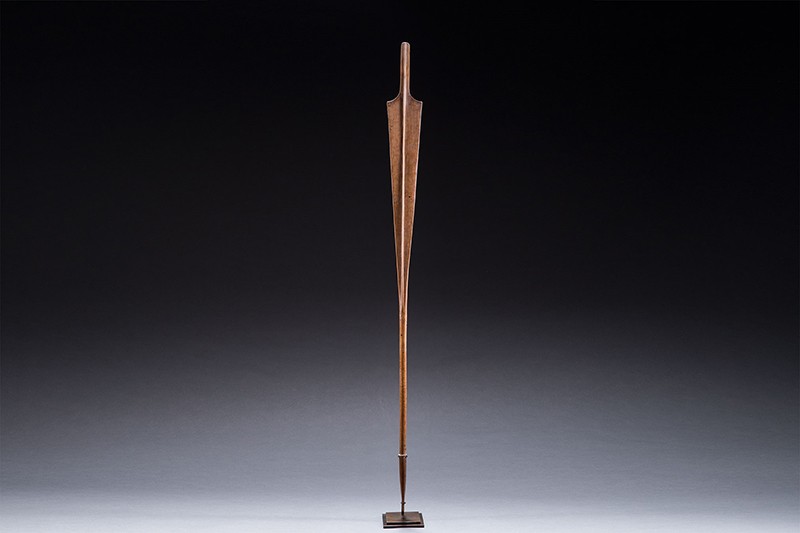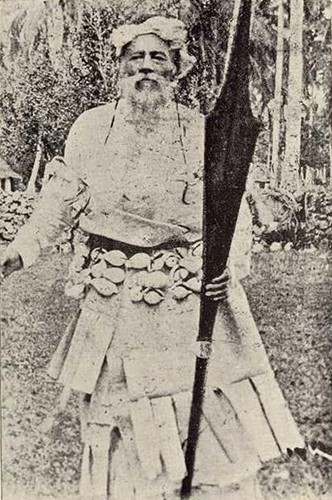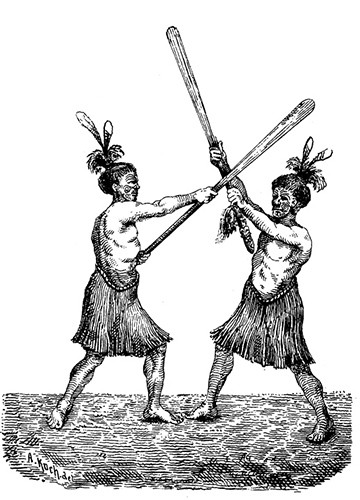 |
Cleaving Club (Ula-fumiti), early to mid 19th Century
Niuean culture; Niue Island, Polynesia
Wood; 68 7/8 x 5 x 1 ¼ in.
2018.4.1
Bowers Museum Purchase |
Behold the Cook-o-nut
Captain Cook was the first European to travel to Niue, a small island in the middle of Polynesia, when he landed ashore late in the spring of 1774. His welcome to the small tropical island was not as friendly as he would have hoped: a spear avoided his head by less than a foot, and his purser’s received the large, hurled stone directly into his shoulder. Feeling somewhat rebuked, Cook returned to his ship and journals dubbing Niue the Savage Island. It was an unfortunate name for Niue—which itself roughly translates to the far more lighthearted, “behold the coconut.” Like so much of the world though, Niue was no stranger to war between its two major groups. The Bowers Museum’s newest acquisition is one of the many weapons of these conflicts, the katoua.
 |
| King Fata-a-iki of Niue bearing a katoua, 1985 |
Classification by Curve
The oldest mentions of a katoua in European writing describe a weapon which falls somewhere between club and halberd and is neatly encapsulated with the term cleaving club. This newly acquired katoua is an authentic example of the often misidentified ula-fumiti subvariant which sets itself apart from standard katoua by having a rounded top as opposed to a pointed one. Other than this distinguishing feature, the shape of the ula-fumiti falls entirely into its parent category. The weapon can vary in length from three to six feet, and broadens at its thickest point to three to six inches before again curving inwards towards its pointed or rounded finial. Many katoua were decorated. Based on the patination around the lower shaft of this club, there is some evidence that this club previously had a rattan grip. Other adornments such as feathers and shells are sometimes seen and there are citations of katoua which have shark’s teeth inserted along the blades.
 |
| The King and Queen of Niue taking a seat guarded by a man with a katoua, c. 1900 |
War Changes
As already mentioned, war was a common enough feature of life on Niue. Sometime prior to the island’s recorded history, a feud started between the Motu of the northern end of the island and the Tafiti of Niue’s south. The result was a never-ending series of ambushes and battles. Fortunately, due to intermarriage on the small island, these skirmishes rarely resulted in the loss of more than a handful of lives. The battles themselves sometimes began with ceremonies arranged to paralyze one’s foe through magic. If this did not succeed throwing the heavy mete stones—objects which Cook’s purser became intimately acquainted with—or spears (tao), was the next step. When the two groups were close enough for melee weapons, it was the katoua which was primarily used.
 |
| An illustration of two Maori men battling with taiaha, a weapon similar to the katoua |
Crack-Katoua
The katoua is best-compared to the Maori taiaha, both in function and how it was used to both attack and deflect incoming blows. The katoua would be held with both hands with the foremost hand just below where the club begins to broaden. In appearance the gently sloping forms of the katoua relied mostly on the bearer to be intimidating, but the weapon was extremely deadly. A late 19th Century ethnographer claimed that the heaviest clubs could “cleave a man’s head down to his shoulders.” This was likely not the case, but a well-aimed strike would indisputably be fatal. The pointed bottom of the club also found common ground with the taiaha, in that it was commonly used to finish off foes on the ground. The finial differentiating ula-fumiti from standard katoua is speculated to be decorative.
 |
| A 2015 series of New Zealand stamps featuring the traditional weapons of New Zealand, two of which are variants of katoua |
Not in the Colonies Anymore
Gottfried Schmidt, likely the collector of this club, was born in Germany 1879 and studied mining engineering and chemistry at university. Germany was then at the height of its colonial power, and it was common for young men to serve in some facet of the military. Schmidt did just that. Not long into his tenure in the German military he spent 1905-1906 stationed in the far-flung German New Guinea as an officer conducting geological surveys. How and when he ventured out to Niue is a small puzzle, as Germany had no hard-and-fast relationship with the lonely island. Niue instead became a British colony in 1901 and remained under English control—at least on paper—until 1974. Though we cannot discount the possibility that Schmidt purchased the katoua from an early Oceanic dealer, family stories and a large personal collection including several thousand books, old German flags, Japanese armor, the keystone of any good explorer: pith helmets, and much more all seem to indicate that he himself was the collector.
Text and images may be under copyright. Please contact Collection Department for permission to use. References are available on request. Information subject to change upon further research.






Comments